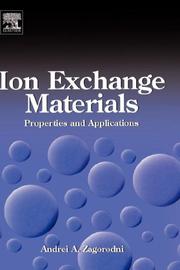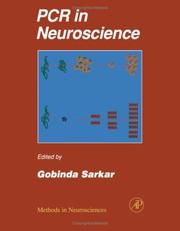| Listing 1 - 3 of 3 |
Sort by
|

ISBN: 9780080445526 0080445527 0080467539 9780080467535 9780080467535 Year: 2007 Publisher: Amsterdam London Elsevier
Abstract | Keywords | Export | Availability | Bookmark
 Loading...
Loading...Choose an application
- Reference Manager
- EndNote
- RefWorks (Direct export to RefWorks)
Ion Exchange Materials: Properties and Applications fills a "two-dimensional" gap in books currently available on the subject. Firstly, there is a lack of modern comprehensive publications on the chemistry of ion exchange materials and on the relationships between their properties and practical applications. Secondly, there are few books on ion exchange chemistry that are targeted to industrial R & D specialists and research students who (i) do not work with ion exchange on a daily basis, (ii) need to develop competence in this area, and (iii) find it difficult to start studying the subject from primary scientific publications. The book bridges these gaps by describing classical and modern theoretical concepts, as well as practical approaches for using ion exchange materials. Ion exchange materials combine properties of homogeneous and heterogeneous materials. Besides being an interesting subject for investigation, they are essential in a wide variety of industrial technologies: in the chemical and biochemical industries, pharmacy, medicine, microelectronics, the nuclear industry, food production, waste treatment, and many other areas. Ion exchange is a powerful tool in chemical analysis and scientific research. The main focus in this book is on ion exchange polymers: ion exchange resins, chelating resins, imprinted (templated), and other functional polymers. It provides an in-depth study of ion exchange materials, suitable for postgraduate students and R & amp;D industrial specialists in chemistry, chemical and biochemical technology. * Comprehensively covers the subject. * Provides links between theoretical concepts, material properties, practical applications, and technical solutions. * Easy to understand - requires only ground knowledge of university-level chemistry and can be read without an in-depth knowledge of mathematics. * Supported with an interactive web-site.

ISBN: 9780121852962 0121852962 9780080536453 008053645X 1281059277 9781281059277 9780121852979 0121852970 9780080536460 0080536468 1281056855 9781281056856 9786611059279 9786611056858 0126192553 9780126192551 Year: 1995 Publisher: San Diego, California : Academic Press,
Abstract | Keywords | Export | Availability | Bookmark
 Loading...
Loading...Choose an application
- Reference Manager
- EndNote
- RefWorks (Direct export to RefWorks)
This practical book provides the detailed methodology and expert guidance required for measuring and manipulating cytosolic ion concentrations. In addition, the strengths, weaknesses, and pitfalls of various techniques are presented. It is an invaluable source for those needing an objective evaluation of current methodologies and for those contemplating setting up such procedures.Key Features* A one-source reference for measuring and manipulating intracellular ions and for comparing and evaluating current methodologies* Includes overviews of* Optical probes and reagents
Polymerase chain reaction. --- Cell physiology. --- Ions --- Physiological effect. --- Analysis.
Multi
ISBN: 9783030971854 9783030971847 9783030971861 9783030971878 Year: 2022 Publisher: Cham, Switzerland : Springer,
Abstract | Keywords | Export | Availability | Bookmark
 Loading...
Loading...Choose an application
- Reference Manager
- EndNote
- RefWorks (Direct export to RefWorks)
This book explains the metabolic processes by which microbes obtain and control the intracellular availability of their required metal and metalloid ions. The book also describes how intracellular concentrations of unwanted metal and metalloid ions successfully are limited. Its authors additionally provide information about the ways that microbes derive metabolic energy by changing the charge states of metal and metalloid ions. Part one of this book provides an introduction to microbes, metals and metalloids. It also helps our readers to understand the chemical constraints for transition metal cation allocation. Part two explains the basic processes which microbes use for metal transport. That section also explains the uses, as well as the challenges, associated with metal-based antimicrobials. Part three gives our readers an understanding that because of microbial capabilities to process metals and metalloids, the microbes have become our best tools for accomplishing many jobs. Their applications in chemical technology include the design of microbial consortia for use in bioleaching processes that recover metal and metalloid ions from industrial wastes. Many biological engineering tasks, including the synthesis of metal nanoparticles and similar metalloid structures, also are ideally suited for the microbes. Part four describes unique attributes associated with the microbiology of these elements, progressing through the alphabet from antimony and arsenic to zinc. .
General microbiology --- General ecology and biosociology --- Environmental protection. Environmental technology --- environment --- microbiologie --- ecologie --- milieutechnologie --- Industrial microbiology. --- Metals --- Metal ions. --- Microbiology. --- Metalls --- Microbiologia industrial
| Listing 1 - 3 of 3 |
Sort by
|

 Search
Search Feedback
Feedback About
About Help
Help News
News